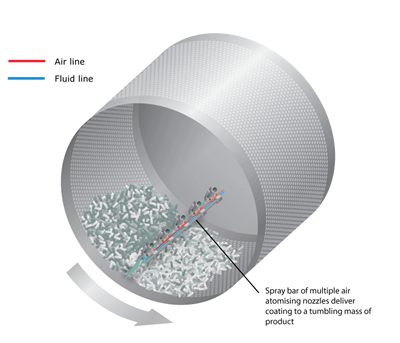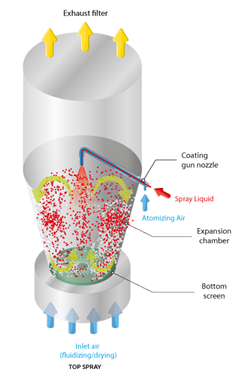
The use of nozzles for the applications of coatings is common in many industries. Broadly speaking coating systems can be broken down into four main groups.
Typical coating applications will involve a spray bar deployed over a product conveyor. A line of spray is produced and the motion along the conveyor ensures the entire product is coated as it passes under the spray bar. Normally such setups deploy flat fan nozzles.
Whilst the conveyor will be moving continuously the product may be spaced at intervals. This means that spraying may only be required when a product passes under the spray bar. If the process is fast moving then such systems will require precise control and this will often mean air-actuated spray nozzles or electrically- actuated nozzles are required.
Dosing can be controlled by the flow through the nozzle as well as by the speed of the conveyor. With electrically- actuated nozzles dosing can also be controled via pulse width modulation. Such nozzles can be cycled on and off 150 times per second. So by using very rapid on/off cycles flow can be reduced without affecting the continuity of the coating.
For simple continuous spraying systems hydraulic flat fan nozzles may be suitable. For systems that require stop start spraying or other more precisely controlled on/off cycles, air or electrically-actuated nozzles will be required. Air atomisation of the spray itself may also be desirable in many coating applications as this can create a very fine spray with small droplet sizes at low flaw rates meaning better cohesion of the coating. (Please click on the nozzle icons below to access data sheets)

In this system product is moved under a spray bar and stopped whilst the coating is applied. The conveyor then moves the product on. This may involve several spray coating points, i.e. multiple applications of spray.
Typically full cone nozzles will be deployed so that an even coating of fluid is delivered to the stationary target. In most cases air actuation of the nozzle will be required to ensure a responsive on/off cycle. Air atomisation of the spray itself may also be suitable to reduce the droplet size to improve cohesion. (Please click on the nozzle icons below to access data sheets)
The coating of pelleted or tablet products needs a different type of system. Running tablets along a conveyor would clearly only coat one side and the sheer number of products would mean turning each one would be impractical. As such these types of product are typically coated in drum coating machines. The uncoated product is moved around in a cylindrical drum whilst spraying a coating fluid is applied. The random motion of the products ensures that an even coating is applied to each product. This type of coating is very common in the pharmaceutical industry for tablet coating.
Typically high precision air atomising nozzles will be used in these applications. As the spray is being directed at a moving mass of many tablets it is desirable to spray very fine droplets. Finely atomised sprays means a greater randomisation of fluid and thus a more even coating. (Please click on the nozzle icons below to access data sheets)

Similar to the drum coating process this variation sets the uncoated tablets moving upwards in a chamber in an air current. The solid product thus becomes ‘fluidised’ i.e. it behaves much like a fluid with randomised movement of individual particles. A spray is injected into the air current so that it hits the moving tablets thus applying the coating. As the tablets are temporarily suspended in an air stream when they come into contact with the coating spray the contact is potentially from all angles and so an even 3d coating can be applied. This process relies on the randomised movements of the target pellets/granules so they behave in a fluid-like way when they meet the similarly randomised droplets. As such the process mimics the mixing of two fluids.
The nozzles required for this type of application need to have very well controlled patterns, droplet sizes and flow rates. Slight areas of overspraying with increased fluid density can, for example, result in product sticking together. As such, SAM nozzles, with their independent air inlets for actuation, atomisation and spray angle are the logical choice. (Please click on the nozzle icons below to access data sheets)


We help you avoid the pitfalls to deliver the quality and value your spray nozzle need, on-time and on budget.
We will contact you within 1 working day, please pay attention to the email with the suffix “info@cycospray.com”.